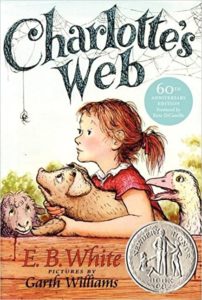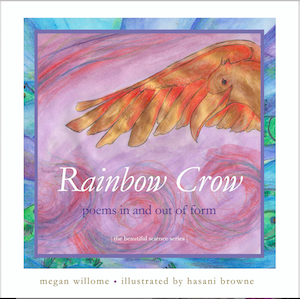Charlotte’s Web: Medieval?
I opened this year’s book review column with C.S. Lewis’ The Discarded Image, a discussion of the medieval novel. I’ve read other books this year that attempted to replicate that ancient style (Laurus, The Book of the Dun Cow) while re-reading Kristin Lavransdatter for a year-long writing project, Project Redux. And it occurred to me that my favorite book of all — Charlotte’s Web — has a perspective that’s more than a little medieval.
It’s earthy
It has rats and pigs and manure. It opens with Papa and his axe, about to kill a runty pig. In the midst of E.B. White’s lovely prose is a lot of earthiness.
Take this paragraph, from the final chapter. It’s a description of fall moving into winter. Any sentimental writer can cover squashes and pumpkins and leaves turning, but White’s fall is littered with wildness — a wildness with gnawing in the night.
The autumn days grew shorter, Lurvy brought the squashes and pumpkins in from the garden and piled them on the barn floor, where they wouldn’t get nipped on frosty nights. The maples and birches turned bright colors and the wind shook them and they dropped their leaves one by one to the ground. Under the wild apple trees in the pasture, the red little apples lay thick on the ground, and the sheep gnawed them and the geese gnawed them and the foxes came in the night and sniffed them.” — from the last chapter, XXII, “A Warm Wind”
It’s thin
The story is not set in the Middle Ages, but in mid-century Maine. But like medieval stories, the line between this world and all the other words is very thin.
We see this most clearly in the animals, when we hear them talking or when we get inside their thoughts. Sure, there are lots of children’s books where animals talk , but it’s rare for a person to be able to hear the animals, as Fern does. When that does happen, the person is often a very special person, with a supernatural understanding-animals gift. But Fern, who sits in the barn all summer, listening, is a regular girl. (Mrs. Arable’s visit to Dr. Dorian confirms her physical and mental health.) By the time summer ends, Ferm has left the thin place of the barnyard for the Ferris wheel and Henry Fussy.
It’s miraculous
Most medieval novels are religious, and Charlotte’s Web is not. But when the adults first notice the words SOME PIG in a spider web, they think they are seeing a miracle. In fact, the chapter where that blessed event happens is titled “The Miracle.” White writes that Lurvy “dropped to his knees and uttered a short prayer.” Mr. Zuckerman consults the minister, asking him to explain this miracle. The minister preaches a sermon about the topic to a full church the following Sunday.
Most of the adults in the story think the miracle is the pig. But there’s always a person outside the authority chain — a child, a person who is blind, someone considered a fool — who gets it right. That person is Mrs. Edith Zuckerman:
Well,” said Mrs. Zuckerman, “it seems to me you’re a little off. It seems to me we have no ordinary spider.”
Well played, Edith.
It’s a tale within a tale
Most medieval novels include a fable or a legend — a story within the story. Charlotte’s Web has a couple of embedded tales: the story of Charlotte’s cousin who caught and devoured a fish, and the story of her other cousin, the aeronaut.
Medieval stories also often have songs, and Charlotte’s Web includes a lullaby sung over Wilbur. It’s a lovely hymn to sleep and darkness, featuring frogs and thrushes … and dung. That word appears twice. How often have you sung your little ones to bed with a song that mentions poop? Well, then, you are not very medieval. (Remember: They liked it earthy.)
It’s heroic
Charlotte does not appear in chapter 1. Or in chapter 2, or in chapter 3. She first speaks to Wilbur at the end of chapter 4, as a voice “rather thin, but pleasant.” Chapter 5, titled “Charlotte,” finally introduces our heroine. She exits at the end of chapter 21, after saving Wilbur. He, in turn, ensures her egg sac is saved (with significant help from a reluctant Templeton).
Her heroism changes some things but not all things. Wilbur’s coveted medal is hung on a nail over the pigpen. Fern never returns to the barn, preferring to pine over Henry Fussy. Charlotte’s children hatch and emerge, and all but three leave the magical world to explore reality. That is the way of pigs and children and spiders.
But few sentences in all literature approach the glory of White’s final two sentences. To lay down one’s life is one kind of heroism. But there is another heroic way, one oh so thin and oh so pleasant:
It is not often that someone comes along who is a true friend and a good writer. Charlotte was both.”
October’s Pages
Poetry
Pieces: A Year in Poems & Quilts, by Anna Grossnickle Hines
The Hurting Kind, by Ada Limón (current poet laureate)
Picture Books and Early Readers
Main Street Mockingbirds, by Amy Schwede Beicker, illus. Diana Godwin Schwede (a history of my town, complete with matching bronze mockingbirds mounted on iconic buildings for a scavenger hunt)
Queen Elizabeth II: A Little Golden Book Biography, by Jen Arena, illus. Monique Dong (Join us for Children’s Book Club, Friday, November 11!)
What Do You Do with a Chance? by Kobi Yamada, illus. Mae Besom
Middle Grade and YA
The Last True Poets of the Sea, by Julia Drake
Charlotte’s Web, by E.B. White
Grownups
Giant, by Edna Ferber
Water from Stone: The Story of Selah, Bamberger Ranch Preserve, by Jeffrey Greene, illus. Margaret Bamberger
Mexican Gothic, by Silvia Moreno-Garcia
healthier homes, by Jen & Rusty Stout
The Understatement of Plowing: Unfiltered Memoirs to the American Public from the Minds of Black Men, by Shonda Kay White
Photo by Michael Muelle, Creative Commons, via Flickr. Post by Megan Willome.
Browse more book reviews with Perspective
Browse more Children’s Book Club
“Megan Willome has captured the essence of crow in this delightful children’s collection. Not only do the poems introduce the reader to the unusual habits and nature of this bird, but also different forms of poetry as well.”
—Michelle Ortega, poet and children’s speech pathologist
- Perspective: The Two, The Only: Calvin and Hobbes - December 16, 2022
- Children’s Book Club: A Very Haunted Christmas - December 9, 2022
- By Heart: ‘The night is darkening round me’ by Emily Brontë - December 2, 2022



Glynn says
It’s been decades since I read “Charlotte’s Web.” After reading your analysis, I have to go back and read it again. I loved Eugene Vodolazkin’s “Laurus.” And his “The Aviator” and “Brisbane.” He also has a new novel on the way – “A History of the Island.”
October Reading
Poetry
“Quadrilateral Utterances” by David Russell.
“Elizabeth Bishop: A Very Short Introduction” by Jonathan Post.
“Against the Woods’ Dark Trunks” by Jack Bedell.
Mystery
“Murder in the Village” by Faith Martin.
“Raw Material” by JJ Marsh.
“The Crimes of Clearwell Castle” by Benedict Brown.
“A Temporary Ghost” by Michaela Thompson.
“Treacherous Strand” by Andrea Carter.
“Murder in the Manor” by Roy Lewis.
“A Long Shadow” by HL Marsay.
Non-fiction
“Mississippi in the Civil War: The Home Front” by Timothy Sutton.
“The Battle of Jackson, Mississippi” by Chris Mackowski.
“Presidential Reconstruction in Mississippi” by William Harris.
“Portraits in Conflict: An Illustrated History of Mississippi in the Civil War.”
“The Limits of Loyalty: Ordinary People in the Civil War in Mississippi” by Jarret Ruminski.
(And why all this reading on Mississippi in the Civil War? A research project on my great-grandfather.)
Megan Willome says
A writing research project? Very exciting!
I hope you do go back and reread “Charlotte’s Web.” I’m guessing it will take you about an hour.
L.L. Barkat says
Megan, I loved this idea… of Charlotte as a medieval novel. How fun. 🙂 (And I’m wondering about a stained glass version of Charlotte now 🙂 )
I’m reading Remarkably Bright Creatures to the girls in the evenings, and it’s such a great story! (HT: Tania Runyan). The writer is masterful at interweaving multiple stories into one and also using setting to communicate things about character (a real talent).
Your “Grownups” section is particularly intriguing this time around. (Feeling very regional, very historical… in a way that’s pulling forward to the Now. 🙂 )
Megan Willome says
Yes, four of the reads this month are on assignment. I always enjoy being pushed to read things I might not stumble upon on my own.
Glad you are enjoying a read-aloud book.